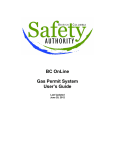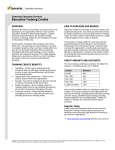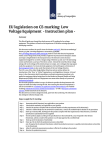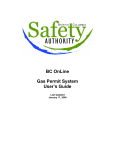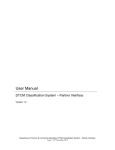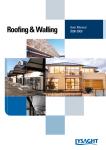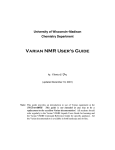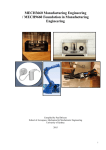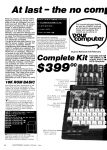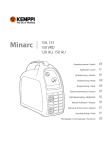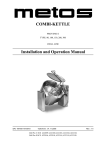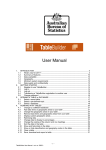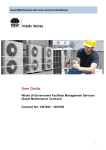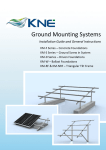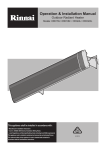Download Gap Training Resource
Transcript
Australian Context Training Resources CPC32411 Certificate III in Plumbing Registered Training Organisation Trainer Manual This resource was funded by the Australian Government Department of Industry, Innovation, Science, Research and Tertiary Education. The views expressed in this publication do not necessarily represent the views of the Minister for Tertiary Education, Skills, Science and Research or the Australian Government. The Australian Government does not give any warranty nor accept any liability in relation to the contents of this work. Developed by: This resource was developed by the Construction and Property Services Industry Skills Council (CPSISC). This work is copyright and is not to be altered without prior permission from: CPSISC, PO Box 151 Belconnen ACT 2616. Ph: (02) 6253 0002 Acknowledgement: Thanks to Andre Lewis and Associates Pty Ltd for consultation and development work. Version Control Final Version Last updated – June 2012 Desktop publishing and images by Easy Guides Australia. 2 Contents Introduction.............................................................................. 4 The Australian Context Training Process ............................... 7 Helping the learner gain essential Australian plumbing knowledge ............................................................................... 8 Work closely with the employer ........................................... 9 Learning on the job ............................................................ 10 OHS ............................................................................... 10 Technical tasks .............................................................. 10 Assessment expectations .............................................. 11 Assessment resources .......................................................... 12 Plumbing Work Experience Profiling Cards .......................... 13 Essential Australian Knowledge ............................................ 14 Occupational Health and Safety ........................................ 15 Workplace Employment and Conditions ........................... 16 Building Code of Australia ................................................. 16 The Plumbing Code of Australia ........................................ 16 Australian signage ............................................................. 17 Regulations for Plumbing Work ......................................... 18 Legislation and Australian standards applicable to plumbing work ................................................................................... 18 3 Introduction This Australian Context Training, Trainer Manual for the Certificate III in Plumbing (CPC32411) will assist you facilitate and assess the essential Australian plumbing knowledge and skills required by overseas trained plumbers. Overseas trained workers seeking employment in the plumbing trade are assessed in their country of origin against the minimum technical competencies required for plumbing work in this country by Trades Recognition Australia (TRA) approved registered training organisations (RTOs). Successful skills assessment applicants receive an Offshore Technical Skills Record (OTSR). This is an Australian industry endorsed record of skills accepted by all state and territory licensing regulators. It allows holders to apply for a provisional licence and work under the supervision of a qualified tradesperson whist they gain their Australian specific knowledge and skills. On successful completion of both the Australian context training and a period of supervised employment, the tradesperson can apply for an Australian Qualification 4 Framework (AQF) qualification (usually a Certificate III) from the TRA-approved RTO that issued the OTSR. More details of the process can be found at: Pathway to occupational licensing for overseas-trained tradespeople RTOs undertaking this Australian context training should provide successful candidates with a Statement of Attainment. It has been agreed that the same requirements for local plumbing training and recognition, the CPC32411 Certificate III in Plumbing, should also be used for offshore assessment of a general plumber: Workers will be deemed to have met the requirements if they have successfully demonstrated competence in specified units of competency from the Construction, Plumbing and Services Integrated Framework Training Package for the streams of: Water – 24 core and 5 elective units Sanitary – 6 core and 4 elective units plus required core and elective units of competency of two streams from the following four: Drainage – 9 core and 3 elective units Mechanical services – 4 core and 11 elective units Roofing – 8 core and 4 elective units Gas services – 12 core and 5 elective units NB. Some units are common to more than one stream and are counted toward completion of the Certificate III 5 Even though an OTSR confirms candidate’s relevant technical skills, they would naturally not be conversant with all the specific Australian knowledge requirements for the plumbing trade. This includes local OHS codes of practice, employment conditions and expectations, the Building and Plumbing Codes of Australia, Australian standards, Australian safety signage and plumbing and services regulatory requirements. Therefore overseas trained workers will need to gain the essential Australian plumbing and services Context knowledge through supervised employment and an Australian Context training program. 6 The Australian Context Training Process This manual has been developed as part of a suite of resources to underpin effective Australian context training of overseas trained plumbing workers. The Australian Context training resources suite includes: a Learner CD and Guide for self-paced learning an Employer Guide Work Experience Profiling Cards this Trainer Manual The resources set out the specific knowledge requirements workers have to gain and the work context for applying this knowledge. Migrant plumbing workers have a maximum of 12 month period of work placement with one or more employers to gain the Australian knowledge they need. As the assigned trainer you will provide training support and periodic assessment to measure progress of the worker. You will also conduct a final assessment to confirm that the worker has gained all the essential Australian context knowledge required. The overseas trained workers that you deal with are likely to be geographically spread out so the learning is designed to be largely self-paced under your guidance; however the worker and/or employer can email or telephone you for advice. Depending on the location of the worker/employer you may be able to have periodic contact with them at the workplace for mentoring and iterative assessment. Even so the final assessment of the Australian Context is intended to be faceto-face. 7 The main learning resource is a learner CD and user manual that provides an interesting and relatively interactive progression through the essential context with periodic selfassessment tools to check their advancement. This selfpaced approach, with oversight by you and the employer/supervisor of the worker, should provide the necessary support for building their essential Australian context knowledge. Helping the learner gain essential Australian plumbing knowledge The new migrant worker has been an experienced plumbing worker in their home country so they can undertake a variety of normal plumbing work in Australia. But as they will not yet have accumulated the considerable wealth of knowledge regarding local regulatory requirements and applicable Australian and other standards they will need relevant learning experiences on-the-job. 8 Work closely with the employer Employers will assist the learning experience by exposing the new worker to activities where they can apply newly acquired plumbing and services knowledge in a workplace context. This is a similar process to an employer guiding an apprentice through relevant plumbing and services work during through their contracted training period, except that the worker is not required to attend an off-the-job training program to learn the Australian knowledge context in the Australian Context training program. The worker and employer can contact you throughout the placement period to confirm or query any aspect of the training program. You should initially contact the employer to agree a training plan that matches the self-paced learning approach with real workplace experience. The suite of Australian Context Training Resources includes simple Work Experience Profiling Cards that the employer and learner will complete to record relevant experience in plumbing and services tasks Each Card covers a discrete area of the Australian plumbing knowledge requirements. There are 10 Cards for the mandatory plumbing streams of Water, and Sanitary plus 4 for the streams of Drainage, Mechanical services, Roofing and Gas services. The 14 cards and a blank template to develop additional cards if required can be downloaded from the CPSISC website. Where the employer’s regular work does not involve a particular area covered by the Cards they will note this on the relevant card so you can ensure the assessment is valid and reliable and/or identify alternative opportunities for the worker to apply the relevant knowledge and skills. 9 Of course, if you have any concerns about how well the learner is picking up or applying the necessary local knowledge, talk to their employer to assist in remedying the situation. Learning on the job OHS To ensure the new worker understands and correctly applies Australian OHS practices, the employer can involve him/her in tasks where this is an underpinning requirement. For example there may be water service installations in a new apartment development. As this will be a construction worksite the worker will have to comply with the normal OHS requirements that apply. This will include achieving the general OHS induction for the construction industry prior to going on-site. Employers will assist the new worker by specifying to him/her beforehand what particular safety aspects they expect to be known and applied while on the job. This could include introducing the worker to particular Material Safety Data Sheets (MSDS) used by the organisation. The employer and other experienced plumbers can also indicate the safety signage on the worksite and check the worker understands and follows them. Technical tasks Another example is in the case of the worker having demonstrated competency overseas in installing gas pressure control equipment. The host employer can, under supervision, give him/her a job of installing over-pressure regulators, including an internal relief and over-pressure shut off (OPSO) valve two stage gas regulator. 10 The employer will want to be sure the finished job operates to the appropriate reduced pressure and that the worker has correctly identified the requirements for installing and commissioning pressure control and regulating equipment. Where using specified plastic pipes/fittings it should be checked that the worker understands and applies relevant aspects of Australian Standard AS/NZS 1462.1:2006 Methods of test for plastic pipes and fittings - Method for determining the dimensions for pipes and fitting. Employers should give the worker access to copies of relevant regulations and Australian standards to study before starting the work. To make sure these on the job learning experiences are working it is important for you as the RTO to assess the learner not only knows the relevant OHS regulations and Australian standards, but also understands the work contexts they apply to. Assessment expectations Being assessed will be a stressful experience for some workers, particularly in a new country and workplace environment. Training practices in some countries can also focus on intensive learning of knowledge disassociated from practical application. If this has been the norm for the worker, and with a lot of unique Australian plumbing and services knowledge context to absorb, they may try to rote learn voluminous material and get disheartened. If this is occurring explain to the learner what is important and that they need to understand what regulations, codes and Australian standards apply to certain work and access them as needed rather than try and recite them all off by heart. You can indicate that the assessment you apply will not expect that either. 11 Assessment resources As an experienced trainer in an RTO scoped to deliver the Certificate III in Plumbing you will have access to resources for assessing every aspect of plumbing and services work. However, this is likely to be in the context of integrated on and off-the-job training through an apprenticeship pathway. The new migrant workers have already had their technical skills assessed and recognised through the TRA process and hold an OTSR to verify this. Your RTO should recognise this and under the Australian Context training program concentrate on the achievement and recognition of the required Australian knowledge Context only. When this is completed successfully the worker can be issued with the CPC32411 Certificate III in Plumbing. Because the worker is using a self-paced resource while working, the assessment is similar to an RPL process. The assessment checklists provided in the Learner Guide will assist them to determine their progress. There are other useful materials that can assist you in supporting the worker and ensuring they receive a reliable and valid assessment. These include National Plumbing and Services Training Advisory Group (NPSTAG) materials accessed through the resource sharing network: http://npstag.brightcookie.com/course/index.php 12 Plumbing Work Experience Profiling Cards These easy to use records will keep track of the plumbing and services work activities the worker has been exposed to in an Australian workplace, and indicate how they have achieved the required outcomes. A complete set of Profiling Cards can be printed from the Learner CD or downloaded from the Construction and Property Services Skills Council website. The Profiling Cards are even more useful in that the type of experiences required to effectively apply the Australian essential knowledge are set out and the employer, the worker and you, the RTO, will all be able to see what has been done and what has not yet been covered. It’s as much a very useful work planning device as a training record. It’s important that the employer and learner complete them on a regular basis and both sign off the entries. 13 Essential Australian Knowledge As mentioned earlier, national work has already been undertaken to identify the key Australian knowledge context for the plumbing trade. This is explicitly referred to in all the units of competency that an overseas plumbing worker is assessed against. Naturally the same OHS, Australian standards or regulatory references occur in many of the units of competency so they have been collated and grouped under particular headings. The following briefly covers each category of essential knowledge and where it may apply in plumbing and services activity. It’s a good guide to what the learner will have to cover and the sort of documents they must access to achieve this. 14 Their self-paced learning kit has more detail and being CD based allows them to follow direct links to relevant regulator or industry websites to get more information. Occupational Health and Safety All units of competency required for the trade of plumbing in Australia include working in a way that is safe for the tradesperson, others working with them and the general public. The Commonwealth and every State and Territory government in Australia is responsible for OHS practices in workplaces and sets comprehensive guidelines for workplace safety. In this regard each unit of competency in the plumbing qualifications refers to Job Safety Analysis (JSA) – Safe Work Method Statements and use of Australian enterprise Material Safety Data Sheets (MSDS). There are also references to specific requirements that apply to safe use of equipment common to trade work. Examples are AS/NZS 4576:1995 - Guidelines for Scaffolding and AS/NZS 1891.1:2007 Industrial fall-arrest systems and devices – Harnesses and ancillary equipment. Plumbing tradespersons also require knowledge of AS/NZS 4994.2:2009 Temporary edge protection - roof edge protection – Installation and dismantling. These standards referenced in the unit CPCPCM2035A - Work safely on roofs applicable to roof plumbing and other plumbing streams. Every activity you require your worker to undertake will have an OHS context so it is important to ensure they understand how they must comply with legislation and apply normal workplace safety procedures. 15 Workplace Employment and Conditions To work effectively in the Australian plumbing and services industry it is necessary to understand the general conditions of employment that apply. New workers should be familiar with normal plumbing industry industrial conditions and their obligations to employers. They should also gain an understanding of the culture of the plumbing trade in terms of working with others as a team, taking responsibility for the quality of their work and the importance of good customer service, among others. Building Code of Australia The Building Code of Australia includes the first and second sections of the National Construction Code (NCC) and sets out the technical requirements for safe and effective building practices and the structural integrity of buildings themselves. As you know many aspects are relevant to plumbing work carried out in residential, commercial and industrial buildings either during construction or for maintenance, repair and installation of plumbing equipment and services. The Plumbing Code of Australia This code is section three of the National Construction Code (NCC) and a significant feature is that it covers sustainable 16 plumbing outcomes for water, energy and the environment and defines the total package of plumbing services including: cold water services heated water services non-drinking water services fire fighting water services sanitary plumbing systems sanitary drainage systems roof drainage systems surface and sub-surface drainage systems heating, ventilation and air conditioning on-site waste water management systems on-site liquid trade waste systems; and the materials and products certification and authorisation (WaterMark) scheme Australian signage This aspect of Australian plumbing and services knowledge covers the specific requirements for construction site signage signifying hazardous areas or activities that workers must be aware of. Construction sites where plumbers will be working will also often interact with pedestrian or vehicle traffic and signage must be used appropriately to warn people of building activity and any safety issues. 17 Regulations for Plumbing Work The complete set of Australian standards covering Plumbing and Drainage is AS/NZS 3500 (Set):2003 (incorporating Amendments for below to 2011) - Plumbing and Drainage Set including: AS/NZS 3500.0:2003 - Glossary of Terms AS/NZS 3500.1:2003 - Water services AS/NZS 3500.2:2003 - Sanitary plumbing and drainage AS/NZS 3500.3:2003 - Stormwater drainage AS/NZS 3500.4:2003 - Heated water services The complete set covering gas installations is AS 5601 (Set):2010 Gas Installation set. Each State/Territory also has legislation and regulations covering plumbing. There can also be legislation relevant to plumbing enforced by local authorities across Australia. It is important that the learner is made aware of these and can access the detailed documentation. Legislation and Australian standards applicable to plumbing work Handling hazardous materials. States and Territories have legislation/regulations covering the transport and handling of hazardous materials. The Australian government has information on environmental protection relevant to building and construction work. States and Territories will also have requirements for installation of pre-treatment facilities for commercial operations. 18 Flash penetration through walls and roofs requires knowledge of: AS/NZS 1562.2:1999 Design and installation of sheet roof and wall cladding – Corrugated fibre-reinforced cement AS 1562.1:1992 /Amdt 2: 1995 Design and installation of sheet roof and wall cladding - Metal SAA HB39-1997 Installation code for metal roofing and wall cladding Manufacturer’s Technical Bulletins for flashing steelcoated roofing and wall cladding materials Building Code of Australia definition of flashing to meet amended weatherproofing provisions Setting out and installing water services require knowledge of: AS/NZS 3500.1:2003/Amdt 2: 2010 Plumbing and drainage - Water services AS/NZS 3500.4:2003/Amdt 2: 2010 Plumbing and drainage - Heated water services Energy rating of appliances should be known by all plumbing workers and include items such as the applicable regulation for the energy rating of water heaters being installed. There are also particular requirements for stationary circulation pumps for heating and service water installations (IEC 60335-2-51 Ed 3, IDT) plus knowledge of: AS 4796:2001 Water supply - Metal bodied and plastic bodied ball valves for property service connection WS-SPEC (CD-ROM) Water Services Specification 19 For water treatment equipment installation there are no applicable Australian standards, however installing water pumps may require knowledge of: AS/NZS 1462.13:2006 Methods of test for plastic pipes and fittings – Method for the determination of elastomeric seal joint contact width and pressure For fire sprinkler and other equipment installation there are relevant Australian standards such as AS 2419.1:2005/Amdt 1:2007 Fire hydrant installations - System design, installation and commissioning; AS 244:-2005/Amdt 1:2009 Installation of fire hose reels and AS/NZS 1221:1997/Amdt 1:2003: Fire hose reels. Also relevant are: AS 2118.10:1995 Automatic fire sprinkler systems - Approval documentation AS 2118.5:2008 Automatic fire sprinkler systems - Home fire sprinkler systems AS 2118.5:2008 Automatic fire sprinkler systems – Home fire systems Planning and installing residential plumbing systems requires knowledge of: AS/NZS 2032:2006/Amdt 1:2008 Installation of PVC pipe systems AS 2439.2:2007 Perforated plastics drainage and effluent pipe and fittings - Perforated effluent pipe and associated fittings for sewerage applications 20 AS/NZS 5065:2005/AMDT 1:2010 Polyethylene and polypropylene pipes and fittings for drainage and sewerage applications In drainage work trench support has relevant Australian standards: AS 4744.1:2000 Steel shoring and trench lining – Design AS 5047:2005 Hydraulic shoring and trench lining equipment Where plumbers install on-site (waste) disposal systems the relevant Australian standards are: AS/NZS 1546.1:2008 On-site wastewater treatment units - Septic tanks AS/NZS 1546.3:2008 On-site domestic wastewater treatment units - Aerated wastewater treatment systems AS/NZS 1546.2:2008 On-site domestic wastewater treatment units - Waterless composting toilets AS/NZS 1547:2000 On-site domestic wastewater management 21 AS 3735:2001 Concrete structures retaining liquids Where plumbers install on-site (waste) disposal systems three relevant Australian standards are: AS/NZS 1546.1:2008 On-site wastewater treatment units - Septic tanks AS/NZS 1546.2:2008 On-site domestic wastewater treatment units Waterless composting toilets AS/NZS 1546.3:2008 On-site domestic wastewater treatment units Aerated wastewater treatment systems AS/NZS 1547:2012 On-site domestic wastewater management AS 3735:2001 Concrete structures retaining liquids Installing roof and wall cladding Australian standards may require knowledge of: AS 1562.1:1992 /Amdt 2:1995 Design and installation of sheet roof and wall cladding - Metal AS 1562.3:2006 Design and installation of sheet roof and wall cladding - Plastic AS/NZS 1562.2:1999 Design and installation of sheet roof and wall cladding - Corrugated fibre-reinforced cement Collecting and storing roof water has relevant standards such as: AS/NZS 3500.3:2003/Amdt 2 : 2010 National Plumbing and Drainage - Stormwater drainage 22 AS/NZS 2179.1:1994 Specifications for rainwater goods, accessories and fasteners - Metal shape or sheet rainwater goods, and metal accessories and fasteners Building Code of Australia: Clause 3.5.2.4 and Installation of gutters and downpipes Specific standards for welding include: AS 1674.1:1997 Safety in welding and allied processes Fire precautions AS/NZS ISO 383.1:2008 Quality requirements for fusion welding of metallic materials – Criteria for the selection of the appropriate level of quality requirements AS 1579:2001 Arc-welded steel pipes and fittings for water and waste-water Knowledge of Welding Technology Institute of Australia (WTIA) Technical Notes – TN-25, TGN-W-01, TGN-W-02, TGN-W-04 on water applications plus TGN-BC-01 and TGND-01 on related welding techniques may also be useful 23 Welding polyethylene pipe requires knowledge of: AS/NZS 4129:2008 Fittings for polyethylene (PE) pipes for pressure applications AS 2492:2007 Cross linked polyethylene (PE-X) for pressure applications AS 2033:2008/Amdt 2 :2009 Installation of polyethylene pipe systems 24 In general Gas fitting requires knowledge of AS/NZS 5601 SET:2010 Gas installations set. AS/NZS 2642.3:2008 Polybutylene (PB) plumbing pipe systems – Mechanical jointing fittings for use with Polybutylene (PB) pipes for hot and cold water applications may also apply for some installation work. Where installing and commissioning Type A gas appliances electrical safety regulations may apply. Each State and Territory has regulations governing safe practices in electrical work. Also relevant is AS/NZS 3820:2009/Amdt 1:2011 Essential safety requirements for electrical equipment Installing LP gas systems has relevant Australian standards such as: SN EN ISO 10239:2008 Small craft - Liquefied petroleum gas (LPG) systems AS/NZS 1596:2008 The storage and handling of LP Gas AS 2658:2008/Amdt 2:2011 LP Gas - Portable and mobile appliances This is a snapshot of the sort of information plumbers in Australia need to know about and access from time to time. The important learning aspect for the worker is an understanding of where regulatory requirements come from, how to interpret relevant aspects of them and apply this in their day-to-day work practices. 25 As mentioned earlier there is no expectation that workers will be assessed on detailed knowledge of particular Australian Standards or the Plumbing Code of Australia, but they should be fully conversant with what codes and standards apply to plumbing work and have a good knowledge of where to find relevant information when a particular job activity requires it. 26


























